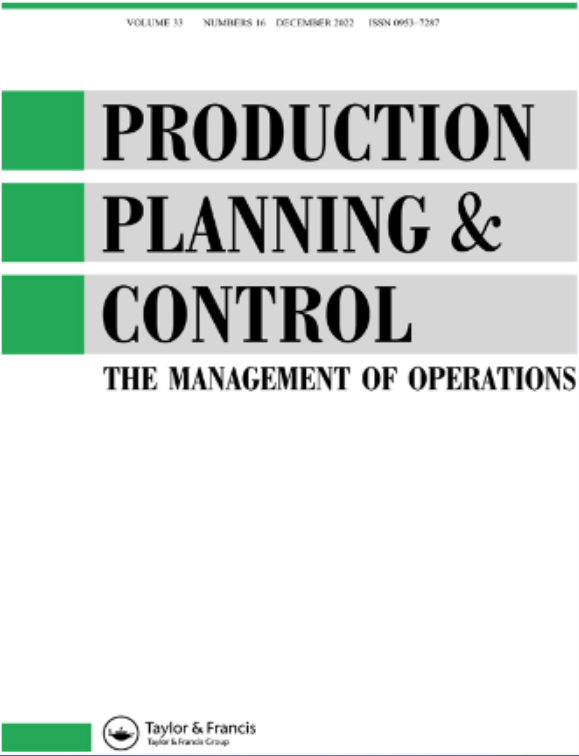All About Pull Production: Designing, Implementing, and Maintaining Kanban, CONWIP, and other Pull Systems in Lean Production
IF 6.1
3区 管理学
Q1 ENGINEERING, INDUSTRIAL
引用次数: 0
Abstract
The whole push versus pull conundrum has been made unnecessarily complicated by academics and practitioners alike. As such, this book promises to challenge the readers’ understanding of pull production – a core tenet in lean manufacturing. In doing so, it aims to bring some clarity to this confusion, and is set to become THE standard reference book on pull systems. With practical experience from Toyota, Bosch, and McKinsey & Company, combined with academic experience from Karlsruhe University of Applied Sciences, the author Prof. Dr. Christoph Roser has done a great justice in sharing more than 400 pages of actionable knowledge about different types of pull system and the various environments in which they can operate. From my personal experiences as a lean teacher, researcher, practitioner, and consultant, I have encountered many individuals that simply equate pull with make-to-order. This is of course in direct contradiction with the original supermarket pull systems developed to support just-in-time production, and one of several misconceptions of pull that are presented and explored by Prof. Roser in his book. As John Shook (Chairman, Lean Global Network) quite rightly points out in the foreword of the book, the widely accepted academic definition of a pull production system, ‘one [a system] that explicitly limits the amount of work in process that can be in the system’ (Hopp and Spearman 2004), is incorrect and has done more harm than good in many practical implementations. In this respect, Roser makes a valiant attempt to right such wrongs, and presents a detailed overview of several alternative, mainstream pull systems, including Kanban, CONWIP, POLCA, and even Drum-Buffer-Rope (DBR). It is also very interesting to read about COBACABANA – a less mainstream approach to pull but still worthy of a mention. And in (Braglia, Marrazzini, and Padellini 2020) you will find the real-world implementation of COBACABANA you are looking for, Christoph! Before going into the precise details of each of these different types of pull system and how one might go about implementing them, Roser provides a very useful assessment tool for practitioners wanting to select an appropriate pull system for their specific application area – be it make-tostock, make-to-order, flow shop, or job shop, for example. The book also covers the fundamentals of the first-in-firstout (FIFO) sequencing method and its alternatives, as well as provides some useful examples of pull systems applied in non-manufacturing settings, such as in Healthcare, Project Management, and Construction. As a fan of the Toyota Production System (TPS) and an avid lean advocate, I am impressed by the sheer extent of knowledge contained within this book regarding the original Kanban system – the history, origins, fundamentals, and variants, including digital Kanban (or e-Kanban, which funnily enough has become popular with the onset of Industry 4.0 but was implemented at Toyota already in 1993!). For those interested in the maths behind pull systems, the book also delivers here – with worked examples for Kanban, POLCA, CONWIP, and Reorder Point calculations; aptly supported with an abundance of figures and illustrations for those of us that are not as numerically gifted as others! Roser concludes that although pull is one of the powerful tools for lean manufacturing – ‘it is still only a tool’. He suggests that companies should rather start with a problem and work towards a solution – which I agree with completely. However, in rethinking lean as a learning system, we have come to realise that the lean tools that are often implemented as solutions for operational excellence instead become learning frames, and as such, pull should otherwise become a means of rapidly surfacing problems (quality, delivery, or otherwise), helping to build further lean capability – fostering a process of discovery, improvement, and learning for everyone in the organisation, every day. Nevertheless, this book – filled to the brim with practical guidance and useful examples – will certainly encourage managers to rethink their strategies, providing the means to create World class supply systems, anywhere, and in any industry.拉动式生产:精益生产中的看板、CONWIP和其他拉动式系统的设计、实施和维护
整个推与拉的难题被学者和从业者都不必要地复杂化了。因此,这本书承诺挑战读者对拉动式生产的理解-精益生产的核心原则。在这样做的过程中,它的目的是为这种混乱带来一些清晰度,并将成为拉系统的标准参考书。作者Christoph Roser教授博士结合丰田、博世和麦肯锡公司的实践经验,以及卡尔斯鲁厄应用科学大学的学术经验,公正地分享了400多页关于不同类型的拉曳系统及其可运行的各种环境的可操作知识。从我作为精益教师、研究者、实践者和顾问的个人经历来看,我遇到过许多人,他们简单地把拉动等同于按订单生产。当然,这与最初为支持准时生产而开发的超市拉动式系统是直接矛盾的,也是Roser教授在他的书中提出和探讨的几种对拉动式的误解之一。正如约翰·舒克(精益全球网络主席)在书的前言中正确指出的那样,被广泛接受的拉式生产系统的学术定义是“明确限制系统中可完成的工作数量的系统”(Hopp和Spearman 2004),这是不正确的,并且在许多实际实施中弊大于利。在这方面,Roser勇敢地尝试纠正这些错误,并详细概述了几种替代的主流拉动系统,包括看板、CONWIP、POLCA,甚至鼓-缓冲-绳索(DBR)。读到COBACABANA也很有趣——一种不太主流的拉扯方法,但仍然值得一提。在(Braglia, Marrazzini和Padellini 2020)中,您将找到您正在寻找的COBACABANA的现实世界实现,Christoph!在深入了解每种不同类型的拉式系统的具体细节以及如何实现它们之前,Roser为从业者提供了一个非常有用的评估工具,帮助他们为自己的特定应用领域选择合适的拉式系统——例如,是库存制造、订单制造、流程车间还是作业车间。本书还涵盖了先进先出(FIFO)排序方法及其替代品的基础知识,并提供了一些在非制造环境中应用的拉系统的有用示例,例如在医疗保健,项目管理和建设。作为丰田生产系统(TPS)的粉丝和一个热心的精益倡导者,我对这本书中所包含的关于原始看板系统的知识范围印象深刻——历史、起源、基础和变体,包括数字看板(或e-看板,有趣的是,随着工业4.0的开始,它已经流行起来,但在1993年丰田已经实施了!)对于那些对拉式系统背后的数学感兴趣的人,本书还提供了看板、POLCA、CONWIP和重新排序点计算的工作示例;为我们这些不像其他人那样有数字天赋的人提供了大量的数字和插图!Roser总结说,尽管拉动是精益生产的有力工具之一,但“它仍然只是一个工具”。他建议,公司应该从一个问题开始,努力找到解决方案——我完全同意这一点。然而,在将精益作为一种学习系统进行重新思考时,我们已经意识到,精益工具通常是作为卓越运营的解决方案而实施的,而不是成为学习框架,因此,拉动应该成为一种快速发现问题(质量、交付或其他)的手段,帮助建立进一步的精益能力——为组织中的每个人每天培养发现、改进和学习的过程。尽管如此,这本书——充满了实用的指导和有用的例子——肯定会鼓励管理者重新思考他们的战略,提供了在任何地方、任何行业创建世界级供应系统的方法。
本文章由计算机程序翻译,如有差异,请以英文原文为准。
求助全文
约1分钟内获得全文
求助全文
来源期刊

Production Planning & Control
管理科学-工程:工业
CiteScore
19.30
自引率
9.60%
发文量
72
审稿时长
6-12 weeks
期刊介绍:
Production Planning & Control is an international journal that focuses on research papers concerning operations management across industries. It emphasizes research originating from industrial needs that can provide guidance to managers and future researchers. Papers accepted by "Production Planning & Control" should address emerging industrial needs, clearly outlining the nature of the industrial problem. Any suitable research methods may be employed, and each paper should justify the method used. Case studies illustrating international significance are encouraged. Authors are encouraged to relate their work to existing knowledge in the field, particularly regarding its implications for management practice and future research agendas.
 求助内容:
求助内容: 应助结果提醒方式:
应助结果提醒方式:


